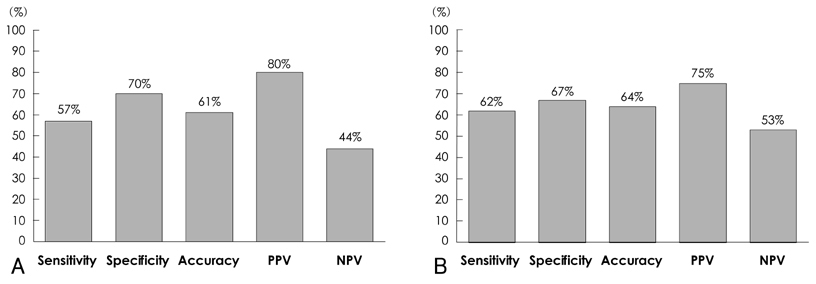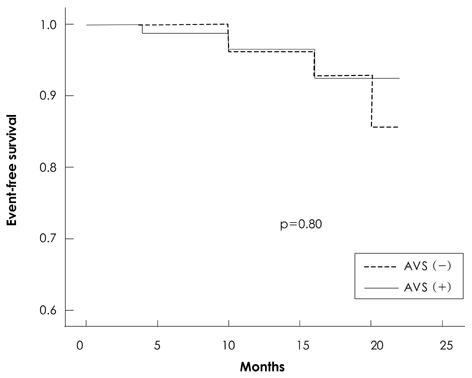Korean Circ J.
2009 Jul;39(7):275-279. 10.4070/kcj.2009.39.7.275.
Aortic Valve Sclerosis on Echocardiography is a Good Predictor of Coronary Artery Disease in Patients With an Inconclusive Treadmill Exercise Test
- Affiliations
-
- 1Division of Cardiology, Department of Internal Medicine, The Catholic University of Korea College of Medicine, Seoul, Korea. hojheart@catholic.ac.kr
- KMID: 2145563
- DOI: http://doi.org/10.4070/kcj.2009.39.7.275
Abstract
- BACKGROUND AND OBJECTIVES
The treadmill exercise test (TMT) is used as a first-line test for diagnosing coronary artery disease (CAD). However, the findings of a TMT can be inconclusive, such as incomplete or equivocal results. Aortic valve sclerosis (AVS) is known to be a good predictor of CAD. We determined the usefulness of assessing AVS on 2-dimensional (2D) echocardiography for making the diagnosis of CAD in patients with inconclusive results on a TMT. SUBJECTS AND METHODS: This prospective study involved 165 consecutive patients who underwent a TMT that resulted in inconclusive findings, 2D echocardiography to detect AVS, and coronary angiography to detect CAD. Following echocardiography, AVS was classified as none, mild, or severe. CAD was defined as > or =70% narrowing of the luminal diameter on coronary angiography. RESULTS: CAD was more common in patients with AVS than in patients without AVS (75% vs. 47%, respectively, p<0.01). Multiple logistic regression analysis showed that AVS was the only independent predictor of CAD {odds ratio=8.576; 95% confidence interval (CI), 3.739-19.672}. The sensitivity, specificity, accuracy, positive predictive value, and negative predictive value of the presence of AVS for predicting CAD in a patient with an inconclusive TMT were 62%, 67%, 64%, 75%, and 53%, respectively. During a 1-year clinical follow-up, patients with and without AVS were similar in terms of event-free survival rates. CONCLUSION: If the results of TMT for patients with chest pain on exertion are inconclusive, the presence of AVS on echocardiography is a good predictor of CAD.
MeSH Terms
Figure
Reference
-
1. Gianrossi R, Detrano R, Mulvihill D, et al. Exercise-induced ST depression in the diagnosis of coronary artery disease: a meta-analysis. Circulation. 1989. 80:87–98.2. Sui SJ, Ren MY, Xu FY, Zhang Y. A high association of aortic valve sclerosis detected by transthoracic echocardiography with coronary arteriosclerosis. Cardiology. 2007. 108:322–330.3. Park YW, Kim DS, Jeong YS, et al. Association between aortic valve sclerosis and risk factors of coronary artery disease in patients with suspected coronary artery disease. Korean Circ J. 2006. 36:374–380.4. Gibbons RJ, Balady GJ, Bricker JT, et al. ACC/AHA 2002 guideline update for exercise testing: summary article: a report of the American College of Cardiology/American Heart Association Task Force on Practice Guidelines (Committee to Update the 1997 Exercise Testing Guidelines). Circulation. 2002. 106:1883–1892.5. Cheitlin MD, Armstrong WF, Aurigemma GP, et al. ACC/AHA/ASE 2003 guideline update for the clinical application of echocardiography: summary article: a report of the American College of Cardiology/American Heart Association Task Force on Practice Guideline (ACC/AHA/ASE Committee to update the 1997 Guideline for the Clinical Application of Echocardiography). Circulation. 2003. 108:1146–1162.6. Jeon DS, Lee MY, Kim CJ, et al. The severity of aortic valve sclerosis is associated with carotid intima media thickness/plaque in neurologically asymptomatic patients. Korean Circ J. 2004. 34:1049–1055.7. Tolstrup K, Crawford MH, Roldan CA. Morphologic characteristics of aortic valve sclerosis by transesophageal echocardiography: importance for the prediction of coronary artery disease. Cardiology. 2002. 98:154–158.8. Mark DB, Shaw L, Harrell FE Jr, et al. Prognostic value of a treadmill exercise score in outpatients with suspected coronary artery disease. N Engl J Med. 1991. 325:849–853.9. Boden WE, O'Rourke RA, Teo KK, et al. Optimal medical therapy with or without PCI for stable coronary disease. N Engl J Med. 2007. 356:1503–1516.10. Pohle K, Maffert R, Ropers D, et al. Progression of aortic valve calcification: association with coronary atherosclerosis and cardiovascular risk factors. Circulation. 2001. 104:1927–1932.11. Otto CM, Lind BK, Kitzman DW, Gersh BJ, Siscovick DS. Association of aortic-valve sclerosis with cardiovascular mortality and morbidity in the elderly. N Engl J Med. 1999. 341:142–147.12. Agmon Y, Khandheria BK, Meissner I, et al. Aortic valve sclerosis and aortic atherosclerosis: different manifestations of the same disease?: insights from a population-based study. J Am Coll Cardiol. 2001. 38:827–834.13. Adler Y, Levinger U, Koren A, et al. Relation of nonobstructive aortic valve calcium to carotid arterial atherosclerosis. Am J Cardiol. 2000. 86:1102–1105.14. Tolstrup K, Roldan CA, Qualls CR, Crawford MH. Aortic valve sclerosis, mitral annular calcium, and aortic root sclerosis as markers of atherosclerosis in men. Am J Cardiol. 2002. 89:1030–1034.15. O'Brien KD, Kuusisto J, Reichenbach DD, et al. Osteopontin is expressed in human aortic valvular lesions. Circulation. 1995. 92:2163–2168.
- Full Text Links
- Actions
-
Cited
- CITED
-
- Close
- Share
- Similar articles
-
- Correlation between Lipoprotein(a) and Abdominal Aorta Thickness and Aortic and Mitral Valve Sclerosis
- Validation of Treadmill Exercise Two-Dimensional Echocardiography in Patients with Coronary Artery Disease
- Coronary Blood Flow Disturbance of a Single Coronary Artery in a Patient Undergoing Aortic Valve Replacement: A case report
- Heart Rate Recovery in Coronary Artery Disease and the Changes of Exercise Parameters after Coronary Stenting
- The Usefulness of Exercise Stress Echocardiography in Diagnosis of Coronary Artery Disease





